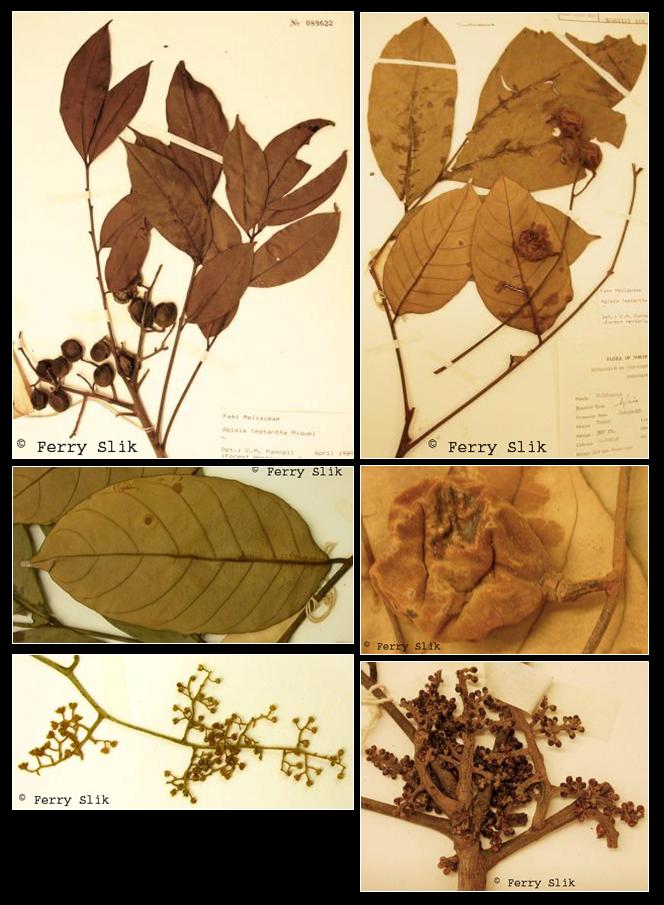Aglaia leptantha Miq., Ann. Mus. Bot. Lugd. Bat. 4 (1868)
Latin for 'with thin flowers'.Synonyms
Aglaia annamensis Pellegr.
Aglaia gamopetala Merr.
Aglaia glabriflora Hiern in Hook.f.
Aglaia glabrifolia Merr.
Aglaia laevigata Merr.
Aglaia leptantha var. borneensis C.DC. in DC.
Aglaia multiflora Merr.
Description
Tree up to 30(-40) m, sometimes flowering and fruiting at 4 m. Up to 132 cm in circumference.
fluted near the base or with small buttresses upwards up to
30 cm and root-like buttresses outwards up to 135 cm. Outer bark pale grey, greenishbrown,
yellowish-brown, or reddish-brown with greyish-green patches, with longitudinal
and transverse cracks and round lenticels; surface of inner bark green and pale
yellow; inner bark green, pale orange-brown or reddish-brown; sapwood pale brown,
pale yellowish-brown, dark orange-brown or reddish-brown, soft; latex white or exudate
pinkish-orange. Twigs slender, densely covered with reddish-brown, pale brown
or grey peltate scales which have a fimbriate margin, when pale, the scales have a dark
grey central spot. Leaves imparipinnate, 30-83 cm long. 20-68 cm wide; petiole 6.5-
16 cm, petiole, rachis and petiolules with few to densely covered with scales like those
on the twigs. Leaflets 7-11 (or 12), 3.5-34 by 1.5-14 cm, dark glossy green above,
paler beneath, young leaflets brownish-green when dry, older leaflets black or blackish green
when dry, acuminate-caudate at apex, broadly cuneate or rounded to a sometimes
subcordate asymmetrical base, lower surface with scales like those on the twigs few to
numerous on the midrib, few on the veins and rarely on the surface in between, sometimes
in Borneo with numerous orange brown stellate hairs, glabrescent. but the scales
present on older parts like those on the twigs, sometimes in Borneo with numerous pits
on upper and lower leaflet surfaces; veins 4-14 on each side of the midrib, black or reddish-
brown when dry; petiolules 2-10(-25) mm. Inflorescence up to 40 cm long and
wide; peduncle up to 10 cm. peduncle, rachis and branches with indumentum like the
twigs. Flowers 1.8-3 mm long, 1.7-3 mm wide, obovoid or ellipsoid, smelling of citronella,
pedicels 0.8-2 mm, densely covered with scales like those on the twigs. Calyx
without or densely covered with scales on the outside. Petals 5. Staminal tube slightly
shorter or longer than the corolla, either with a shallowly 5-lobed aperture c. 0.5 mm in
diam. or with a minute apical pore at the apex c. 0.3 mm across, occasionally with a
few stellate scales on both surfaces or simple hairs inside; anthers 5. narrowly ovoid,
inserted about 1/6-1/3 up the tube and included or just protruding, with a few pale
brown stellate scales. Infriictescence up to 10 cm long and 5 cm wide with few fruits;
peduncle up to 6 cm with surface like the twigs and few to numerous hairs or scales like
those on the twigs. Fruits 1.5-3.2 cm long and 1.5-3 cm wide, ellipsoid or subglobose,
sometimes laterally compressed and then c. 2.3 cm thick, with a longitudinal ridge encircling
the fruit; the pericarp either thin or hard and woody and up to 5 mm thick, brown,
orange, yellow, white or green, densely covered with pale brown stellate scales on the
outside; fruitstalks c. 2 mm. Locules 1 or 2, each containing 1 seed. Seed up to 2.3 cm
long, 1.4 cm wide and 1 cm thick, ovoid, the inner surface flattened; with a complete
gelatinous, translucent, sweet-sour edible aril. [from Flora Malesiana]
Ecology
Found in primary forest, including seasonal swamp, ridge forest, montane
forest and in kerangas; on sandstone, ultramafic, limestone, sand, granitic sand, clay and podzolic
sand; 20-1700 m altitude.
Uses
The durable timber is used. The fruits are edible.
Distribution
Indo-China and Thailand to the Moluccas.
Local names
Borneo: Langsat-langsat, Lantupak, Segera.
